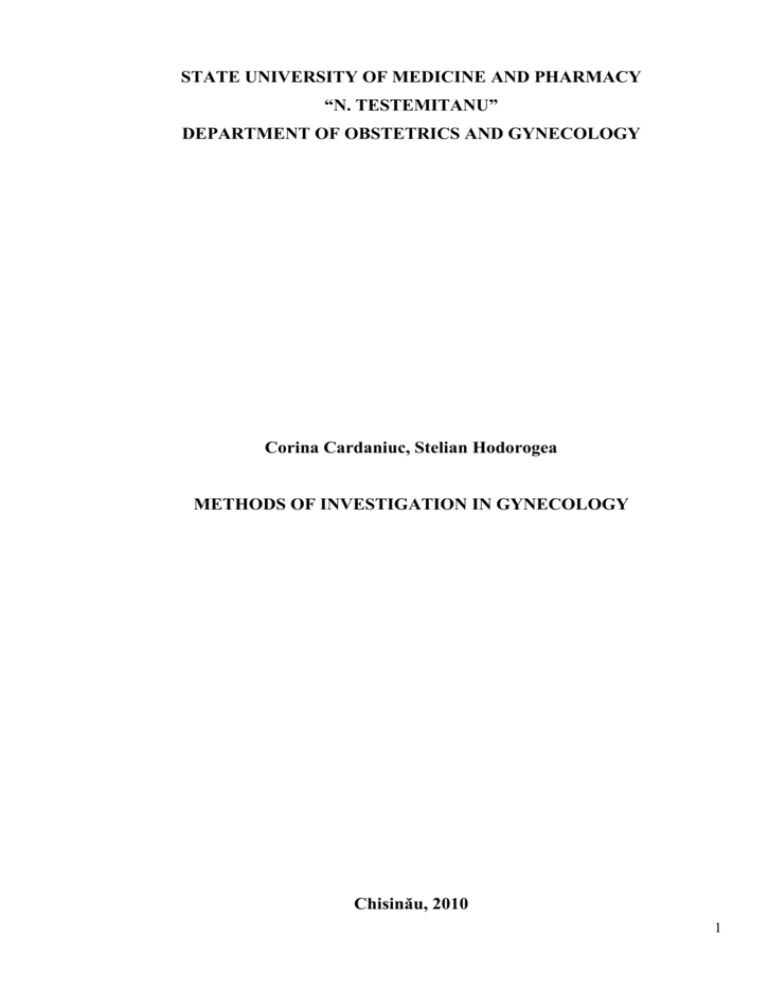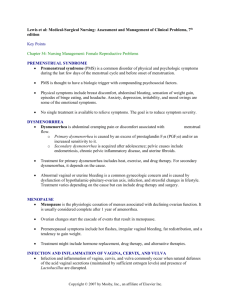tests which confirm occurrence of ovulation……………….26
advertisement

STATE UNIVERSITY OF MEDICINE AND PHARMACY “N. TESTEMITANU” DEPARTMENT OF OBSTETRICS AND GYNECOLOGY Corina Cardaniuc, Stelian Hodorogea METHODS OF INVESTIGATION IN GYNECOLOGY Chisinău, 2010 1 CZU: 618.1-071(076) C-24 The paper includes the selected data from the speciality literature that describe the methods of investigation used in gynecology, methodology, indications, contraindications and possible complications. This teaching material is designed for students of State University of Medicine and Pharmacy “N. Testemitanu”. It was Approved at the Department of Obstetrics and Gynecology from 05/12/2010, a report no. 11 and Central Methodology Commission SUMP “ N. Testemitanu” from 01.12. 2010, report no 1. Reviewers: Rodica Comendant - PhD, Associate Professor Nadejda Codreanu - PhD, Associate Professor ISBN 2 SUMMARY GYNECOLOGICAL EXAM……………………………………………………… 4 HISTORY……………………………………………………………………………5 PHYSICAL EXAMINATION……………………………………………………...7 GENERAL EXAMINATION ………………………………………………………7 GYNECOLOGIC EXAMINATION ………………………………………….……8 ABDOMINAL EXAMINATION…………………………………………………..8 BREAST EXAMINATION…………………………………………………………9 PELVIC EXAMINATION………………………………………………………….12 INSPECTION…………………..……………………………….12 SPECULUM EXAMINATION ………………………………...12 PALPATION……………………………………………………14 BIMANUAL EXAMINATION………………………………...15 RECTOVAGINAL EXAMINATION………………………….16 LABORATORY STUDIES………………………………………………………..16 VAGINAL MICROSCOPY………………………………………………………..16 THE PAPANIKOLAOU TEST (PAP SMEAR)………………………………….18 BIOPSY…………………………………………………………………………….22 CERVICAL BIOPSY………………………………………………………………22 ENDOMETRIAL BIOPSY…………………………………………………………24 TESTS WHICH CONFIRM OCCURRENCE OF OVULATION……………….26 BASAL BODY TEMPERATURE………………………………………………..26 CHANGES IN CERVICAL MUCUS……………………………………………..27 GYNECOLOGICAL CYTOLOGY……………………………………………….28 HORMONE TESTS………………………………………………………………..30 LABORATORY EVALUATION OF AMENORRHEA…………………………30 PROGESTERONE CHALLENGE TEST…………………………………………30 ESTROGEN- PROGESTERONE CHALLENGE TEST ………………………..31 GnRH (GONADORELIN) STIMULATION TEST ………………………………31 CLOMIPHENE (Clomid) STIMULATION TEST ………………..……………….33 3 ENDOSCOPIC METHODS OF INVESTIGATION ……………………………….33 COLPOSCOPY…………………………………………………………………….33 HYSTEROSCOPY………………………………………………………………….34 LAPAROSCOPY …………………………………………………………………...37 RADIOLOGICAL METHODS……………………………………………………38 HYSTEROSALPINGOGRAPHY…………………………………………………38 MAGNETIC RESONANCE IMAGING………………………………………….39 ULTRASOUND EXAMINATION………………………………………………….40 BIBLIOGRAPHY…………………………………………………………………...41 4 GYNECOLOGICAL EXAM Gynecological examination can be a routine checkup for women or an evaluation of a specific problem. Routine examinations are usually done annually on women who are in their childbearing years. The gynecological assessment will be considered under three headings: - history - examination - investigations HISTORY A medical history is collected information on the past and present medical conditions of a patient and any known medical conditions in the patient’s family. A medical history is routinely obtained prior to a physical examination. Personal information - Name, age, date of birth - Marital status - Partner’s occupation Chief symptoms - duration - periodicity - severity and description The patient’s health at the onset of illness and the symptoms in sequence of development form the present illness are recorded. As much detail as is possible is included, documenting what, where, when, why, how, and to what degree each complaint affects her. PAST HISTORY MENSTRUAL HISTORY includes the following: - the age and character of the menarche or menopause - the last menstrual period (LMP), - the previous menstrual period (PMP), - the last normal menstrual period (LNMP) 5 - the regularity, duration and amount of bleeding - pain or symptoms of premenstrual syndrome - mucous discharge - intermenstrual or postcoital spotting OBSTETRICAL HISTORY includes the following: - the number of previous pregnancies - the number of previous term pregnancies - the number of previous abortions - the number of previous premature deliveries - the number of living children - abnormalities of pregnancy, labor, puerperium. In some patients, a more detailed obstetric history is indicated, including dates of all pregnancies; their duration, character, and duration of labor; and method of delivery. Complications, weight and gender of infant(s), stillbirths, abortions, neonatal complications, and current status of living children are noted also. GYNECOLOGIC HISTORY includes information about the patient’s sexual and reproductive health (previous Pap smear results, fertility problems, history of urinary tract infections, sexually transmitted disease) SEXUAL HISTORY includes the following: - Frequency of coitus - Libido - Dyspareunia - Sexually transmitted diseases - Age and health of partner CONTRACEPTION - method - satisfaction with the method - any side effects Additional notes are made about the duration of present marriage, patient’s assessment of the relationship, age and health of spouse/partner, former marriages or 6 relationships (when and how long) and degree of compatibility, vaginal and pelvic infections, and sexually transmitted diseases. MEDICAL AND SURGICAL HISTORY includes the following: - a summary of the patient’s childhood and later illnesses in chronologic order together with complications and the treatment prescribed - medical and nonmedical allergies - any excessive bleeding potentially indicative of a coagulopathy - surgical operations and injuries, with dates and outcome - all medications as well as alternative health care (medications, acupuncture, etc.). FAMILY HISTORY includes the following: - age, health, cause and date of death of first- through third-degree relatives - familial or hereditary abnormalities, diseases - bleeding tendencies, - occurrence of cancer tuberculosis, - diabetes mellitus, - heart disease, - hypertension, and - nervous or mental disorders. SOCIAL HISTORY includes the following: - occupation - conditions of work - smoking habits - alcohol habits - use of drugs PHYSICAL EXAMINATION VITAL SIGNS At the minimum, the patient’s blood pressure, and pulse are recorded. The temperature and respirations are also useful, but more often recorded if related to the chief complaint. 7 GENERAL EXAMINATION includes the following: - height - weight - patient’s appearance - state of nutrition - attitude - color of skin - a systemic examination is made special attention to the reproductive system GYNECOLOGIC EXAMINATION The gynecologic evaluation devotes particular attention to examination of the breasts, abdomen, and pelvis. A general examination is performed before. An appraisal of other body systems is done when indicated by the history or unusual physical findings. ABDOMINAL EXAMINATION The abdomen is examined with the patient sitting, and then examine in the dorsal recumbent position with knees slightly flexed to improve abdominal relaxation. Inspection – note the following: - the contour (flat, scaphoid, or protuberant) - respiratory movement - prominence or enlargement of internal organs - asymmetry - herniations - operation scars - significant skin changes (e.g., striae, rashes) - hair distribution. Auscultation is performed in each of the quadrants. Palpation. The abdomen is palpated gently for evidence of tenderness, herniation, or masses. Deeper palpation will reveal deep masses or sensitivity. The liver is identified by percussion and the edge is palpated. Upper abdominal palpation 8 screens the gallbladder, epigastrium, and spleen. Progressing from areas of less tenderness to the areas of discomfort facilitates examination. Rebound tenderness is a sign of peritoneal irritation and must be investigated further. BREAST EXAMINATION The purpose of the breast exam is to feel the woman's breasts for any lumps or irregularities. The breast exam is usually done just before routine pelvic exams. A complete physician breast examination is recommended every 2–3 years for women age 20–40. Women > 40 should have at least annual examinations. Timing: Follicular Phase (Estrogen only). Most information will be gained in a menstruating woman immediately after menses when hormonal changes in the breast are at a minimum. 1. Less engorgement 2. More comfortable 3. Preferably between days 5-10 Inspection. With the patient sitting in good light with her arms at the side, a visual inspection is performed (fig. 1). Figure 1. Inspection of breasts (Pernoll, M.L. Handbook of Obstetrics and Gynecology. Tenth Edition Medical Publishing Division New York 2001). 9 The patient is asked to press her hands on her hips (tensing the pectoralis muscles), and the inspection continued. With her arms raised above her head, both breasts and axillae are examined. Finally, the patient is asked to bend forward from the erect position to reveal irregularities or dimpling when the breasts fall forward. The health provider must look for: a. Symmetry b. Masses c. Skin retraction d. Skin Color and texture e. Nipple and Areola Palpation. With the patient sitting, the patient is asked to extend her arms 60- 90°. Careful palpation of each axilla is performed using the flat of the fingers of the right hand for the left axilla and the left hand for the axilla. With the patient leaning forward , bimanual palpation of each breast is performed using the flat of the fingers (fig. 2). Figure 2. Palpation of breasts with the patient supine and arm abducted (Pernoll, M.L. Handbook of Obstetrics and Gynecology. Tenth Edition Medical Publishing Division New York 2001).. 10 With the patient supine and arms above the head, the breasts are again inspected. The axillas are reassessed with the patient’s arms extended. The breasts are palpated between the examining fingers. Finally, with the woman’s arms relaxed at the sides, careful palpation of each breast quadrant is performed by compression against the chest wall. Gentle compression of the areola and nipple will detect masses and express fluid. The breasts are observed for: - consistency - thickened areas - irregularities - nodular masses - cordlike duct structures - nipple discharge It is determined whether masses are fixed to the skin or chest wall. Examination of Lymph nodes: the Supraclavicular, Infraclavicular and Axillary areas are carefully palpated for masses (fig. 3). Figure 3. Palpation of axillary and supraclavicular regions for enlarged lymph nodes (Pernoll, M.L. Handbook of Obstetrics and Gynecology. Tenth Edition Medical Publishing Division New York 2001). 11 Mammography. The American Cancer Society guidelines for mammographic screening of asymptomatic women recommend the following: ● Baseline mammogram for all women age 35–40 years ● Mammography at 1–2 year intervals from age 40 to 49 years ● Annual mammograms for women >50 years High-risk women (previous breast cancer, mothers or sisters with breast cancer, histological abnormalities associated with subsequent breast cancer) should have biannual examinations and annual mammography. PELVIC EXAMINATION The pelvic examination consists of inspection and palpation. The patient must have an empty bladder. INSPECTION. Observation of the external genitalia identifies labial development, hair distribution, and abnormalities. Gentle lateral traction separates the labia majora and facilitates inspection of the clitoris as well as both labia minora. Separation of the labia minora allows visualization of the urethral meatus. The vaginal orifice is observed for vaginal discharge and the status of the hymen. Inflammation, cysts, or tumors in the region of Bartholin’s glands are noted. The fossa navicularis may reveal discharge, scars (episiotomy), or lesions (condylomata, etc). Further inspection and palpation over the perineum, mons veneris, and perianal region may reveal skin changes, masses, and tender areas. Any external genital lesions (inflammation, hypertrophy, atrophy, or ulcerated areas) are recorded. SPECULUM EXAMINATION. This is an essential part of the gynecological examination. A speculum is an instrument, described as looking like the bills of a duck, with two blunt, slightly rounded pieces of plastic or metal that, when closed, can be inserted into the vagina. The speculum is most easily inserted by holding the blades slightly obliquely to the axis of the vagina while directing them downward and inward at approximately 45º to avoid the urethra (fig. 4). As the blades of the bivalve speculum approach the cervix, opening the instrument allows the blades to slip into the anterior and posterior fornices, fully 12 expose the cervix. Normally, the cervical os is small and round in nulliparous and slit like after child birth. The cervix is covered by smooth pink epithelium. Figure 4. Speculum examination. The inspection of cervix includes the following: - color - size - position - contour - surface characteristics - the squamocolumnar junction Lacerations, displacement, size and configuration of the external os, distortion or ulceration, type and amount of discharge, blood, or fluid present in the cervical canal; and the character of the endocervix are noted. Vaginal surfaces are inspected slowly removing the speculum. Notable features include: color the apparent thikness of the mucosa the presence or absebce of rugae 13 any abnormalities: redness, ulceration, tumors When cystocele, rectocele, or descensus is suspected, the insertion of a single blade of the speculum and having the patient bear down helps to demonstrate the degree of relaxation. Striping Skene’s glands and the distal urethra after removal of the speculum facilitates determination of infection in these areas. PALPATION / BIMANUAL EXAMINATION The gloved, lubricated index finger is inserted into the vagina by applying slight downward pressure at the fourchette. After that, the middle and forefinger of the examining hand are inserted into the vagina (fig. 5). Figure 5. Palpation/Bimanualexamination. Palpation of Structures of Introitus looks for: - tenderness, masses and thickening at the introitus - enlargement and/or sensitivity of Bartholin’s glands - palpation of the urethra and base of the bladder to detect relaxation - local dilatation, masses, and tenderness Palpation of Cervix determines its: - size - position 14 - contour - consistency - dilation - tenderness upon moving the cervix from side-to-side BIMANUAL EXAMINATION The bimanual examination includes palpation of the uterus, ovaries, and uterine tubal areas. Wearing latex gloves, the doctor will insert one or two lubricated fingers into the vagina and press on the lower abdomen with the other hand, in order to physically feel the woman's internal genital organs. Generally, the vaginal fingers are used to elevate structures for palpation through the abdominal wall. Palpation of Uterus notes its: size shape consistency contour orientation mobility tenderness with motion A normally free uterus usually can be moved well downward and forward by the abdominal hand. This makes possible vaginal palpation of the anterior wall and the uterine fundus. Exploration of the posterior fornix and uterosacral ligaments may reveal masses, fullness, fluctuation, and sensitivity, but acute tenderness in this region may inhibit examination. Palpation of Adnexa The ovary usually lies just lateral to the uterus near its midportion. By moving your abdominal hand to the left lower quadrant and your pelvic hand into the left or right lateral fornixes, the ovaries may be felt between the fingertips of two hands. The ovary is normally sensitive (tender), distinguishing it from nontender masses, such as fecal material within the bowel. 15 The palpation determines: - position - size - consistency - contour - mobility - and any unusual tenderness of each ovary The ovary may not be palpable in the postmenopausal woman, in women on oral contraceptives, prior to adolescence, in the obese, and in women with abdominal scarring. Normally, the uterine tube is not sensitive, and cannot be palpated. Tenderness, swelling, or a cordlike thickening between the ovary and the uterus indicates tubal disease. RECTOVAGINAL EXAMINATION The rectovaginal examination must include palpation of vagina, rectum, and rectovaginal septum as high as the cul-de-sac. Rectovaginal examination should be performed routinely even if all of the internal genital structures have been palpated properly on vaginal evaluation. Anal abnormalities, lesions of the rectovaginal septum, and sacral masses may be felt only on rectovaginal examination. This examination is invaluable in children, virgins, and elderly women, in whom the vaginal introitus is too small. LABORATORY STUDIES VAGINAL MICROSCOPY The normal vaginal ecosystem is a complex environment with dynamic interrelationships among endogenous microflora and their metabolic products, host metabolic products, estrogen, and pH. Normal vaginal discharge is composed of white blood cells, red blood cells, epithelial cells, and bacteria. Cultures will usually show lactobacilli, streptococci, staphylococci, yeast, and various gram-negative bacteria. The various microbes 16 influence the presence of one another and contribute to a woman's unique vaginal ecosystem. Lactobacilli acidophilus are the dominant bacteria in a healthy vaginal ecosystem. Lactobacilli are a gram-positive, aerobic or a facultative anaerobic, nonspore forming organisms. Lactobacilli help to maintain the normal vaginal pH (3.8 to 4.5) by producing lactic acid, which balances the vaginal ecosystem, and hydrogen peroxide, which suppresses the growth of gram-negative and gram-positive facultative and obligate anaerobes. When lactobacilli are absent the protective acidity of the vagina disappears. In this case, the vaginal environment becomes alkaline. This environment promotes overgrowth of coccoid bacteria, often resulting in an infection called bacterial vaginosis. Age, phase of the menstrual cycle, sexual activity, contraceptive choice, pregnancy, presence of necrotic tissue or foreign bodies, and use of hygienic products or antibiotics can disrupt the normal ecosystem. Estrogen influences the health of the vagina by stimulating an increase in the glycogen level, cervical mucus, and epithelium thickness. During childbearing years, a pH of 4.5 or less indicates vaginal health, whereas a pH of 5 or higher is usually a sign of vaginal disruption. Direct microscopic examination of vaginal secretions, Gram-stained vaginal preparations, specific cultures, KOH exam and nucleic acid detection techniques can be used to diagnose the constituents of the vaginal flora. Cultures may detect smaller amounts of yeast in vaginal samples. The wet preparation and potassium hydroxide (KOH) examination are simple techniques for microscopic examination of samples from the vaginal mucosa and skin surrounding the vaginal opening. Diagnostic Value. Candidiasis, vaginal trichomoniasis, and bacterial vaginosis are commonly diagnosed using the vaginal wet preparation and KOH exams. Test Procedure for Vaginal Wet Preparation. A sample of the vaginal discharge is placed on a glass slide and mixed with a salt solution. A coverslip is placed over the sample. The slide is looked at under a microscope at low and high 17 magnifications for bacteria, yeast cells, trichomoniasis (trichomonads), white blood cells that show an infection or clue cells that show bacterial vaginosis. Test Procedure for Vaginal Sample KOH Examination. Using a swab, a sample of vaginal discharge is placed on a microscope slide. A drop of KOH solution is added to determine if an odor develops as this is indicative of bacterial vaginosis. Gram staining is a rapid, easily learned laboratory technique. The advantages of such a procedure, particularly as augmentation to wet mounts, suggest that adoption of Gram staining may be of great use in the clinical area. A microbiological culture, or microbial culture, is a method of growing a microbial organism to determine what it is, its abundance in the sample, or both. THE PAPANIKOLAOU TEST (PAP SMEAR) Is a medical screening method, invented by Georgios Papanikolaou, primarily designed to detect premalignant and malignant processes in the ectocervix. It may also detect infections and abnormalities in the endocervix and endometrium. The test is effective in detecting precancerous conditions and cervical cancer in its early stages. The test aims to detect and prevent the progression of HPV-induced cervical cancer and other abnormalities in the female genital tract by sampling cells from the outer opening of the cervix of the uterus and the endocervix .The sample is stained using the Papanikolaou technique. It is generally recommended that sexually active females seek Pap smear testing annually. The American Cancer Society (ACS) recommends that women have their first Pap smear three years after first having sexual relations, or at age 21 if they have not been sexually active. After the age of 21 years, the ACS recommends the following schedule: Age Frequency 21 to 29 Once yearly using the regular Pap smear 30 to 69 Every two or three years after three consecutive normal Pap smears 18 70 or older Stop having Pap smears after three consecutive normal Pap smears and normal Pap smears over a 10-year period Women with certain risk factors need to be screened annually or on a more frequent. These women may have the following risk factors: History of more than one sexual partner Multiple sex partners at present Partner who began sexual activity at an early age or who had many previous sexual partners Infection with the human papillomavirus (HPV). HPV types 16 and 18 are a major cause of cervical cancer History of other sexually transmitted diseases (e.g., herpes, chlamydia) Tobacco use Other factors that may warrant an annual or more frequent Pap smear include: Family history of cervical cancer Diagnosis of cervical cancer or previous precancerous Pap smear Exposure to DES (diethylstilbestrol) before birth Test Procedure for Papanikolaou test. During the speculum examination when the cervix is first exposed, a specially designed small plastic or wooden spatula is used to scrape the squamocolumnar junction. Endocervical cells are obtained separately, using a small brush within the endocervix. Exfoliated cells from the posterior vaginal fornix may be obtained by spatula. The material from each site is immediately placed on separate slides, and a preservative spray or solution is applied. Signs of malignancy. Anisocytosis (inequality in cell size), anisonucleosis (inequality in nuclear size), hyperchromatism (dense chromatin material in the nucleus), and the bizarre nuclear configurations of atypical mitoses with fragmentation will be among the diagnostic signs of cellular pathology. 19 Bethesda PAP SMEAR system. Most laboratories currently report findings using the Bethesda Pap Smear system (1991 revision). Squamous cell abnormalities are classified according to biologic potential: ● Low-grade squamous intraepithelial lesions (LGSIL) include grade I cervical intraepithelial neoplasia (CIN), also termed mild dysplasia, and human papillomavirus lesions. ● High-grade squamous intraepithelial lesions (HGSIL) include moderate and severe dysplasia (CIN II and III). ● Atypical squamous cells of undetermined significance (ASCUS) identify cells that need further studies to identify if they are reactive or neoplastic. ● Similarly, atypical glandular cells of undetermined significance (ACGUS) require additional qualification as to reactive or neoplastic nature. This system has been updated in April 2001. The most important modifications are the following: the suppression of the category « satisfactory but limited by å, the reintegration of benign modifications in the normal category, « atypical squamous cells of undetermined significance å which have been named « atypical squamous cells å and subdivided in « atypical squamous cells of undetermined significance å and « cannot exclude high grade squamous intraepithelial lesion å and endocervical adenocarcinoma in situ which is now a separate entity. The low grade squamous intraepithelial lesions and high grade squamous intraepithelial remain unchanged. General categorization (optional) - Negative for Intraepithelial Lesion or Malignancy - Epithelial Cell Abnormality: See Interpretation/Result (specify "squamous" or "glandular" as appropriate) - Other : See Interpretation/Result (e.g. endometrial cells in a woman > 40 years of age) Interpretation/Result - Negative for intraepithelial lesion or malignancy (when there is no cellular evidence of neoplasia, state this in the General Categorization above and/or in the Interpretation/Result section of the report, whether or not there are 20 organisms or other non-neoplastic findings: Trichomonas vaginalis, fungal organisms, shift in flora suggestive of bacterial vaginosis, cellular changes consistent with Herpes simplex virus, reactive cellular changes associated with inflammation, radiation, intrauterine contraceptive device, atrophy). - Other: Endometrial cells (in a woman > 40 years of age) - Epithelial cell abnormalities Squamous cell o Atypical squamous cells of undetermined significance o Low grade squamous intraepithelial lesion encompassing: HPV/mild dysplasia/CIN 1 o High grade squamous intraepithelial lesion encompassing: moderate and severe dysplasia, CIS/CIN 2 and CIN 3 o with features suspicious for invasion (if invasion is suspected) o Squamous cell carcinoma Glandular cell o Atypical endocervical cells endometrial cells glandular cells o Endocervical adenocarcinoma in situ o Adenocarcinoma endocervical endometrial extrauterine not otherwise specified - Other malignant neoplasms (specify) Currently, Pap smear remains a screening test and should only assign a probability of disease in an individual. The vaginal smear does not displace the biopsy technique. Smear findings must be confirmed by biopsy previous to therapy. Studies of the accuracy of conventional cytology report: 21 sensitivity 72% specificity 94% BIOPSY. Biopsy is a method for determining the nature of a uterine lesion or functional disorder of the gynecological system. CERVICAL BIOPSY A cervical biopsy is the removal of tissue from the cervix to be analyzed for cellular abnormalities, precancerous conditions, or cervical cancer. A cervical biopsy is performed to detect cancer of the cervix or precancerous lesions of the cervix. Types of cervical biopsies include (fig. 6): Punch Biopsy: A surgical procedure to remove a small piece of tissue from the cervix. One or more punch biopsies may be performed on different areas of the cervix. In a cervical punch biopsy, the cervix may be stained with iodine solution in order to see abnormalities better. Cone Biopsy or Conization: A surgical procedure that uses a laser or scalpel to remove a large cone-shaped piece of tissue from the cervix. Both normal and abnormal cervical tissues are removed. Endocervical Curettage: A surgical procedure in which a narrow instrument called a curette is used to scrape the lining of the endocervical canal. Indications. A cervical biopsy may be performed when cervical abnormalities are found during a pelvic examination, or abnormal cells are found during a Pap test. Cells that appear to be abnormal, but are not cancerous at the present time, are identified as precancerous. The appearance of these abnormal cells may be the first evidence of cancer that may develop years later. A cervical biopsy is often performed as part of a colposcopy procedure, also called a colposcopy-guided cervical biopsy. Problems that may be biopsied or monitored include: Abnormal patterns in the blood vessels Areas that are swollen, worn away, or wasted away (atrophic) Whitish patches on the cervix A cervical biopsy may also be used in the following conditions: 22 Polyps on the cervix. Genital warts, which may indicate infection with human papilloma virus (HPV), a risk factor for developing cervical cancer. Diethylstilbestrol (DES) exposure in women whose mothers took DES during pregnancy, as DES exposure increases the risk for cancer of the reproductive system. Figure 6. Types of cervical biopsies (www.moondragon.org/.../cervicalbiopsies.jpg) Complications Possible complications may include the following: Excessive bleeding Surgical-wound infection. In addition, cone biopsies may increase the risk for infertility and miscarriage because of the changes and scarring in the cervix that may occur as a result of the procedure. 23 Certain factors or conditions may interfere with a cervical biopsy. These factors include the following: Menstruation. Acute pelvic inflammatory disease. Acute inflammation of the cervix. ENDOMETRIAL BIOPSY Endometrial biopsy is a procedure in which a tissue sample is obtained from the endometrium , and is checked under a microscope. The tissue is examined for cell abnormalities or signs of cancer. An endometrial biopsy is the only procedure used to discover endometrial cancer. Indications Abnormal uterine bleeding, postmenopausal bleeding. The biopsy will indicate the presence of fibroids, polyps or other abnormal tissues. Cancer screening Detection of precancerous hyperplasia and atypia Follow-up of previously diagnosed endometrial hyperplasia Evaluation and Treatment of Infertility. If taken several days before menstruation, the biopsy can show the response to estrogen and progesterone to see if ovulation has occurred. The presence of secretory endometrium confirms that ovulation has taken place. Evaluation of uterine response to Hormone Replacement Therapy. Contraindications Pregnancy Acute pelvic inflammatory disease Clotting disorders (coagulopathy) Acute cervical or vaginal infections Cervical cancer The procedure of endometrial biopsy (fig.7) This procedure may be performed with or without anesthesia, by vacuum aspiration or by curettage. 24 Generally, an endometrial biopsy follows this process: - A pelvic examination will be done - A speculum is inserted into the vagina and opened to expose the cervix. The cervix will then be cleansed with an antiseptic solution. - A tenaculum holds the cervix steady for the biopsy. - A small, hollow plastic tube or a biopsy curette is passed into the uterine cavity. - Gentle suction or a scraping removes a sample of the lining. The tissue sample and instruments are removed, and the sample is examined under a microscope. Figure 7. Endometrial biopsy (http://www.lancastergeneral.org/greystone/images/ei_1999.gif) Complications Infection Perforation of the uterus Prolonged bleeding Slight spotting 25 TESTS WHICH CONFIRM OCCURRENCE OF OVULATION BASAL BODY TEMPERATURE Basal body temperature is the body temperature measured immediately after awakening and before any physical activity has been undertaken. In women, ovulation causes an increase of one-quarter to one-half degree Celsius in basal body temperature (BBT). Monitoring of BBTs is one way of estimating the day of ovulation. The tendency of a woman to have lower temperatures before ovulation, and higher temperatures afterwards, is known as a biphasic pattern. Charting of this pattern may be used as a component of fertility awareness. Hormonal causes of biphasic patterns The higher levels of estrogen present during the pre-ovulatory (follicular) phase of the menstrual cycle lower BBTs. The higher levels of progesterone released by the corpus luteum after ovulation raise BBTs (fig. 8). Figure 8. Hormonal causes of biphasic patterns (en.wikipedia.org/...) The rise in temperatures can be seen the day after ovulation. If pregnancy does not occur, the disintegration of the corpus luteum causes a drop in BBTs that coincides with the onset of the next menstruation. If pregnancy does occur, the corpus 26 luteum continues to function and maintain high BBTs for the first trimester of the pregnancy. Very rarely, the corpus luteum may form a cyst. A corpus luteum cyst will cause BBTs to stay elevated and prevent menstruation from occurring until it resolves, which could take weeks or months. Records of basal body temperatures can be used to determine if a woman is ovulating, and if the length of the post-ovulatory (luteal) phase of her menstrual cycle is sufficient to sustain a pregnancy. 18 consecutive days of elevated temperatures means a woman is almost certainly pregnant. BBTs only show when ovulation has occurred; they do not predict ovulation. CHANGES IN CERVICAL MUCUS During the menstrual cycle changes take place in the mucus produced by the cells lining the cervical canal. To determine the pattern of changes, it is best to record the color, consistency, amount, and slipperiness of the cervical mucus. Cervical mucus can be recognized by sensation, by appearance and by testing with the fingertip. Indications Natural Family Planning Pre-ovulatory relatively infertile phase (Immediately after menstruation). There will be no visible mucus. A feeling of dryness or a positive sensation of nothingness at the vulva will be experienced. The fertile phase. As the estrogen levels rise with approaching ovulation, the mucus ecomes more profuse, and there may be up to a tenfold increase in volume. It gives a sensation of lubrication or slipperiness at the vulva. The appearance is similar to that of raw egg white, thin, watery and transparent. On finger-testing this highly fertile mucus may stretch for several inches before it breaks. Fertile mucus maintains the life of sperm, nourishes it and allows it to pass freely through the cervix. Peak day. Peak day denotes the LAST day on which this highly fertile-type slippery, transparent, stretchy mucus is seen or felt. 27 Post-ovulatory completely infertile phase. During the post-ovulatory phase, the slippery sensation is lost and there is a relatively abrupt return to stickiness or dryness again. The amount of cervical mucus decreases and it becomes sticky. This mucus is not as stretchy as the previous mucus. The vulva becomes dry again. This subjective symptom reflects the presence of progesterone, which thickens the mucus again forming a plug at the cervix acting as an impenetrable barrier to sperm. Finger Testing (fig. 9) A finger-tip is used to test the capacity of the cervical mucus to stretch. It may feel sticky and break easily, or it may feel smoother and slippery like raw egg white and stretch between the thumb and first finger, from a little up to several inches before it breaks. GYNECOLOGICAL CYTOLOGY The vaginal smear is useful in fertility studies because the vaginal and uterine cycles are the result of the ovarian cycle. The daily fluctuations in the ovarian hormonal balance as well as the time of ovulation may be identified by the structure and arrangement of the cells in the patient's daily smear. There are four fundamental types of vaginal epithelial cells: basal, parabasal, intermediate or superficial cells. Basal and parabasal cells are the smallest epithelial cells seen on a typical vaginal smear. Basal and parabasal cells are prevalent on smears taken during diestrus and anestrus, and not uncommon during early proestrus. Parabasal cells are absent during estrus. Intermediate cells vary in size and shape, but typically have a diameter two to three times that of parabasal cells. Intermediate cells are prevalent during all stages of the cycle except estrus. Superficial cells are the largest cells seen on a vaginal smear. They are polygonal in shape and distinctly flat, sometimes having the appearance of being rolled up. Their nuclei are absent or pyknotic (very small and dark). Superficial cells without nuclei are often referred to as being "fully cornified". 28 Sensation at Vulva Finger Test Appearance Moist or Sticky Early Mucus Scanty Thick White Sticky Holds its shape Wetter Transitional Mucus Increasing Amounts Thinner Cloudy Slightly Stretchy Slippery Highly Fertile Mucus Profuse Thin Transparent Stretchy (like raw egg white) Figure 9. Finger testing (www.fertilityuk.org/nfps401.html) 29 Under the influence of high estrogen levels due to growth of the follicle, the vaginal mucosa thickens and the blood supply is increased, but not fast enough to keep pace with the growth of the stratified epithelium, so the superficial cells undergo degenerative changes called cornification. These superficial cells appear in the smear as large, flat, polygonal epithelial cells filled with a horny (keratohyalin-like protein) substance in the cytoplasm, which stains red or pink in eosin (acidophilic or eosinophilic) and having small, dense hyperchromatic nuclei (pyknotic). When luteinization occurs in the ovarian follicle, which results in the formation of the corpus luteum, progesterone is produced which affects the vaginal walls by inducing mucification and desquamation of its cells. The sloughed-off aggregations of sticky, folded, cornified cells reflect in the vaginal smear the antagonistic or inhibitory action of progesterone against estrogen. Because the squames mature in a fairly direct relation to the blood estrogen level, it is possible to estimate this effect by the degree of squamous maturation. The most accurate estrogen indices are obtained from the lateral vaginal wall scrape. Indications of hormonal cytology: - assessment of ovarian function - diagnosis of follicular persistency - diagnosis of hormone producing tumors in young children and in postmenopausal women HORMONE TESTS Estimation of serum progesterone is the most commonly used method for confirming ovulation. Progesterone is produces by corpus luteum and elevated levels are seen in the luteal phase. Progesterone levels peak in the midluteal phase and should be checked seven days before next menstrual period. LABORATORY EVALUATION OF AMENORRHEA PROGESTERONE CHALLENGE TEST The progesterone challenge test is done by giving progesterone 10 mg once daily for 7-10 days or one intramuscular injection of 100-200 mg of progesterone in oil IM for one dose. A positive response is any bleeding that occurs within 1-2 weeks 30 after the progestin is given. This bleeding will usually occur 2-7 days after the progestin is finished. If the woman bleeds after progesterone is withdrawn, this indicates firstly that a uterus is present, and secondly that there is some circulating estrogen but the woman is not ovulating (anovulation). If the progesterone challenge test is negative, it is appropriate to give estrogen and progesterone. Failure to bleed in response to this treatment confirms a uterine problem. If no withdrawal bleeding occurs, either the patient has very low estrogen levels or there is a problem with the outflow tract such as uterine synechiae (adhesions) or cervical stenosis. ESTROGEN- PROGESTERONE CHALLENGE TEST - the Next Step (to Distinguish Between Hypoestrogenism or an Outflow Tract Obstruction) Procedure: administer Estrogen-Progesterone: oral conjugated estrogen 1.25 mg orally daily for 21 days or Estradiol 2 mg orally daily for 21 days with progesterone (10 mg daily) on days 17 through 21. A positive test is withdrawal bleeding between days 2 and 7 after finishing medication. If bleeding occurs, amenorrhea is due to hypoestrogenism (hypothalamic amenorrhea or premature ovarian failure). If bleeding does not occur, then most likely it is an outflow tract obstruction - either Asherman's syndrome or cervical stenosis. GnRH (GONADORELIN) STIMULATION TEST may be of use to differentiate between hypothalamic and pituitary causes of amenorrhea: - Give 100 ug GnRH intravenously. - Measure LH and FSH response with samples at 0, 20 and 60 minutes. - Normal peak LH-response: 3-10 fold increase above baseline, within 15-30 minutes. - Normal peak FSH-response: 1.5-3 fold increase above baseline, within 15-30 minutes. - In pituitary disease: absent or blunted response. - In hypothalamic disease: normal response but repeated stimulation may be needed (daily infusions of LHRH for 1 week). 31 LABORATORY EVALUATION OF AMENORRHEA (Du Plessis, M. 2001) Amenorrhea Pregnancy test (B-HCG) Prolactin TSH Positive Antenatal care Increased (> 20 ug/l) Repeat after excluding drugs TSH Free T4 TSH Free T4 Imaging of the pituitary for prolactinoma Primary hypothyroidism Primary hyperthyroidism Progesterone challenge test Withdrawal bleeding LH/FSH ratio > 2.5 No withdrawal bleeding Estrogen priming LH/FSH Normal Bleeding PCOS No bleeding Anovulation Pituitary or hypothalamic disease FSH and LH (< 5U/l)/N GnRH-stimulation test (Clomiphene stimulation) Negative imaging Functional cause Positive imaging Organic cause FSH + LH (> 40 U/l) Outflow tract defect Primary gonadal failure Karyotyping if < 30 years 32 CLOMIPHENE (Clomid) STIMULATION TEST may be useful to distinguish organic causes of gonadotrophin deficiency (pituitary or hypothalamic pathology) from functional disorders and idiopathic delayed puberty. - In healthy adults clomiphene blocks estrogen feedback mechanisms in the hypothalamus, thus leading to a rise in GnRH (gonadotrophin-releasing hormone) and consequently circulating LH and FSH. - Give Clomid 50 mg bd orally for 7 days. - Blood samples are collected for LH and FSH at baseline and after clomiphene stimulation (day 8). - Normal response: Increase in LH (> 120% above baseline) and FSH (> 40% above baseline). A normal response essentially rules out organic causes of hypogonadotrophic hypogonadism and in delayed puberty is an indication that sexual maturity will ensue. In hypothalamic-pituitary pathology there is no response. ENDOSCOPIC METHODS OF INVESTIGATION COLPOSCOPY Colposcopy is a medical diagnostic procedure to examine the cervix and the wall of the vagina. It is performed using a special microscope, called a colposcope, which gives a magnified view of tissue lining the cervix and vagina. The main goal of colposcopy is to prevent cervical cancer by detecting precancerous lesions early. Colposcopy allows the examiner to take tissue samples (biopsies) from specific areas that do not look normal. Indications for colposcopy: assessment of diethylstilbestrol (DES) exposure in utero immunosuppression such as HIV infection, history of abnormal cells on previous colposcopic exams an abnormal appearance of the cervix abnormal Pap test results During the procedure, acetic acid solution and iodine solution (Lugol's or Schiller's test) are applied to the surface to improve visualization of abnormal areas. 33 Three percent acetic acid is applied to the cervix using cotton swabs. The transformation zone is a critical area on the cervix where many precancerous and cancerous lesions most often arise. This solution will react with the abnormal cells – abnormal tissue will appear white – allowing it to be identified through the colposcope. Areas of the cervix which turn white after the application of acetic acid or have an abnormal vascular pattern are considered for biopsy. Schiller's test or Schiller's Iodine test is a medical test in which iodine solution is applied to the cervix in order to diagnose cervical cancer. Lugol's iodine solution is applied to the cervix under direct vision. The iodine solution stains the normal portions of the cervix, but does not stain abnormal tissues. Normal cervical mucosa contains glycogen and stains brown, whereas abnormal areas, such as early cervical cancer, do not take up the stain. The abnormal areas can be biopsied and examined histologically. HYSTEROSCOPY The Histeroscopy is an endoscopic examination that consists in direct vision of the uterine cavity (fig. 10). With hysteroscopy it is possible to estimate normality of the uterine cavity and the aspect of the endometrium. Figure 10. Hysteroscopy (www.aly-abbara.com/livre_gyn_obs/images/hysteroscope_souple_app.html) 34 Hysteroscopy is a minimally invasive intervention that can be used to diagnose and treat many intrauterine and endocervical problems. Hysteroscopic polypectomy, myomectomy, and endometrial ablation are commonly performed procedures. Indications of the diagnostic Histeroscopy: Abnormal uterine bleeding, Sterility and infertility, Diagnosis of cytological doubts reports, Control of the endometrium in menopause, Control of the endometrial hyperplasia, Intrauterine Stadiation of the endometrial carcinoma. Indications of the operative Histeroscopy: Extraction of “lost IUD” Resection of septa, submucous fibroids and polyps, Polypectomy Myomectomy. Ablation of endometrial Adhesions (Hysteroscopic adhesiolysis) Sterilization Proximal tubal obstruction Evacuation of retained products of conception in selected cases Contraindications: Active cervical or uterine infection A large uterine cavity (longer than 10 cm in length -clinically similar to a 12-wk pregnant uterus) Severe medical conditions precluding surgery Pregnancy Instrumentation: Half of distension of the uterine cavity: in natural conditions the uterine cavity is a virtual cavity, and therefore for being able to examine it it is necessary to supply to its distension by (carbon dioxide gas or a liquid solution. Habitually the CO2 in the diagnostic Histeroscopy is used, reserving to the operative Histeroscopy means of distension liquids (solution physiological or more often 35 glicina). The advantage of fluid over gas is the symmetric distention of the uterus with fluid and its effective ability to flush blood, mucus, bubbles, and small tissue fragments out of the visual field. Both low-viscosity and highviscosity fluid media can be used for distention. Normal sodium chloride solution and lactated ringer solution are isotonic, conductive, low-viscosity fluids that can be used for diagnostic hysteroscopy and for limited operative procedures. Two major disadvantages associated with these solutions include (1) their miscibility with blood, which obscures visibility with bleeding, leading to the need for increased volumes to clear the operative field, and (2) their excellent conductivity, which precludes procedures that use standard monopolar electrosurgery. The hypotonic, nonconductive, low-viscosity fluids 5% mannitol, 3% sorbitol, and 1.5% glycine improve visualization when bleeding occurs. They can be used in diagnostic as well as operative hysteroscopy. The only high-viscosity medium available, Dextran 70 is a nonelectrolytic, nonconductive fluid that can be used in all types of procedures. It is immiscible with blood and minimally leaks through the cervix and tubes, allowing for excellent visibility during surgical procedures. Optical system: the Hysteroscope is a thin (diameter of 3-4 millimetre) tube that is inserted into the vagina to examine the cervix and inside of the uterus. Trough the hysteroscope passes the light and the gas for the uterine cavity distension. Hysteroscopes are available in different styles, including rigid and flexible hysteroscopes, contact hysteroscopes, and microcolpohysteroscopes. The diameter of each instrument varies and is an important consideration. For the operative Histeroscopy a hysteroscope of 7-8 millimetres is used, through which to introduce also the small instruments operatives. Complications pelvic infection uterine perforation, bowel perforation, resulting in acute peritonitis bleeding 36 cervical laceration intrauterine infection electrical and laser injuries LAPAROSCOPY Laparoscopy is direct visualization of the peritoneal cavity, ovaries, outside of the tubes and uterus by using a laparoscopy. The laparoscopy is an instrument like a miniature telescope with a fiber optic system which brings light into the abdomen. Carbon dioxide (CO2) is put into the abdomen through a special needle that is inserted just below the navel. This gas helps to separate the organs inside the abdominal cavity, making it easier for the physician to see the reproductive organs during laparoscopy. The gas is removed at the end of the procedure. Microlaparoscopy a new minimally invasive diagnostic surgical procedure uses telescopes and instruments that are much smaller than normal. Indications for gynecologic laparoscopy include the following: Pelvic pain. Infertility investigation. Beside inspection, the patency of fallopian tubes can be demonstrated by observing the passage of methylene blue dye injected throuth the cervix (hydrotubation). If the fallopian tubes are patent, due can be seen spilling out of the end of each tube. Endometriosis. Tubal ligation. Tubal (ectopic) pregnancies. Pelvic inflammatory disease. Repairing damaged fallopian tubes. Lysis of adhesions (removing scar tissue). Laparoscopic assisted vaginal hysterectomy. Removal of ovarian cysts or the entire ovary. Evaluation and removal of pelvic lymph nodes. Diagnosis and treatment of some uterine anomalies. Destroying or removing some uterine fibroid tumors. 37 Complications - Perforation of the viscus, especially bowel. - Hemorrhage from damage to vessels or from a trocar puncture. - Infection is very rare. Contraindications - generalized peritonitis - intestinal occlusion - very obese subjects RADIOLOGICAL METHODS HYSTEROSALPINGOGRAPHY Hysterosalpingography is a radiologic examination of the uterus and fallopian tubes following the injection of a contrast agent into the uterine cavity through the vagina and cervix. This examination reveals the size, shape and location of the uterus and fallopian tubes. The procedure may be performed to identify conditions such as polyps and fistulas. It can be used to detect tumors, scar tissue, or tears in the lining of the uterus. Most often, however, it is performed to determine whether the fallopian tubes are open. This procedure is often used to diagnose infertility in women. If the fallopian tubes are open the contrast medium will fill the tubes and spill out into the abdominal cavity. It can be determined whether the fallopian tubes are open or blocked and whether the blockage is located at the junction of the tube and the uterus (proximal) or whether it is at the end of the fallopian tube (distal). Indications Infertility Repeated miscarriages Uterine tumors Intrauterine adhesion Developmental disorders Obstruction of the Fallopian tubes Traumatic injury Tubal adhesions 38 The presence of foreign bodies Adenomiosis Contraindications pregnancy current or past pelvic inflammatory disease (PID) menstruation or vaginal bleeding of unknown origin Complications - infection, - allergic reactions to the materials used, - embolisation. Factors that increase the risk for complications include: Untreated sexually transmitted disease Recently performed dilation and curettage procedure Vaginal bleeding of unknown cause Pre-existing heart or kidney disease MAGNETIC RESONANCE IMAGING Magnetic resonance imaging (MRI), or nuclear magnetic resonance imaging (NMRI), is primarily a medical imaging technique most commonly used in radiology to visualize detailed internal structure and limited function of the body. MRI provides much greater contrast between the different soft tissues of the body than computed tomography (CT) does, making it especially useful in oncogynecological imaging (staging of gynecological cancers, diagnosis of recurrence of gynecological cancer, diagnosis of trophoblastic tumors). Knowing the normal myometrial characteristics of the uterus MRI allows identification of pathologic alterations such as leiomyomas and adenomyosis. Leiomyomas have various appearances depending on the presence or absence of calcium, hyaline or cystic degeneration, and hemorrhage. On imaging, uteri with adenomyosis are enlarged and have smooth external configurations. MRI is particularly useful for assessing the endometrium, which can easily be identified and distinguished from the myometrium. MRI is able to define depth of 39 myometrial invasion, tumor site, and cervical involvement in patients with endometrial cancer. Several types of ovarian lesions are particularly well evaluated by MRI; these include hemorrhagic cysts endometrial cysts, benign teratomas, and simple follicular cysts. ULTRASOUND EXAMINATION Pelvic ultrasound can help to identify and evaluate a variety of urinary and reproductive system disorders. In women, a pelvic or abdominal ultrasound is most often performed to evaluate the: bladder. ovaries. uterus. cervix. fallopian tubes. Ultrasound examinations can help diagnose symptoms experienced by women such as: pelvic pain abnormal bleeding other menstrual problems and help identify: palpable masses such as ovarian cysts and uterine fibroids ovarian or uterine cancers There are two types of pelvic ultrasound: abdominal (transabdominal) vaginal (transvaginal, endovaginal) for women A transvaginal ultrasound is usually performed to view the endometrium or the lining of the uterus, including its thickness, and the ovaries. Transvaginal ultrasound also affords a good way to evaluate the myometrium. These exams are typically performed to detect: uterine anomalies uterine scars 40 endometrial polyps fibroids cancer, especially in patients with abnormal uterine bleeding Ultrasound is the first-line imaging method for discrimination between viable intrauterine pregnancy, miscarriage and tubal pregnancy in women with bleeding and/or pain in early pregnancy, for discrimination between benign and malignant adnexal masses and for making a specific diagnosis in adnexal tumors (e.g. dermoid cyst, endometrioma, hemorrhagic corpus luteum, etc.), for diagnosing intracavitary uterine pathology in women with bleeding problems, and for confirming or refuting pelvic pathology in women with pelvic pain. BIBLIOGRAPHY 1. Bowen, R. Classification of Vaginal Epithelial Cells Last updated on April 11, 1998.www. vivo.colostate.edu./hbooks/pathphys/reprod/vc/cells.html 2. Chase, D.M., Kalouyan, M., DiSaia, P.J. Colposcopy to evaluate abnormal cervical cytology in 2008. Am. J. Obstet. Gynecol. 200 (5): 472–80. www//linkinghub.elsevier.com/retrieve/pii/S0002-9378(08)02431-9. 3. Cornforth , T. What Is a Colposcopy? ACOG Patient Education Pamphlet AP135. Colposcopy. Updated February 18, 2010. http://www.acog.org/publications/patient education/bp135.cfm 4. Du Plessis, M. Laboratory investigation of amenorrhea. University of Pretoria, 23 February 2001. 5. Hamilton-Fairley, D. Obstetrics and Gynaecology. Published by Blackwell Publishing Ltd, Second edition, 2004, 336 p. 6. Hysteroscopy From Wikipedia, the free encyclopedia Copyright © November 2008 by the American College of Obstetricians and Gynecologists. 7. Katz, V.L. Diagnostic procedures. Imaging, endometrial sampling, endoscopy: indications and contraindications, complications. In: Katz VL, Lentz GM, Lobo 41 RA, Gershenson DM, eds. Comprehensive Gynecology. 5th ed. Philadelphia, Pa: Mosby; 2007: chap 11. 8. Kay, H, Spritzer, C, Magnetic resonance imaging Glob. libr. women's med., (ISSN: 1756-2228) 2008; DOI 10.3843/GLOWM.10067 9. Kuntz, C. "Endometrial biopsy". Can Fam Physician. 2007 January; 53(1): 43– 44. http://www.ncbi.nlm.nih.gov/pmc/articles/PMC1952554/. Retrieved March 11, 2010. 10. Lil, V. Imaging in gynecology. Baillière's best practice & research. Clinical obstetrics & gynaecology. 2006, vol. 20, no 6, 247 p. 11. Moon Dragon's ObGyn Information Procedures. Colposcopy and Cervical Biopsy. WebMD Medical Reference from Healthwise. Last Updated: December 13, 2009 www.moondragon.org/.../colposcopy.html 12. Pelvic Ultrasound. www.radiologyinfo.org/en/info.cfm?.. 13. Pernoll, M.L. Handbook of Obstetrics and Gynecology. Tenth Edition Medical Publishing Division New York 2001, 909 p 14. Peter, C. Cervical biopsy – Overview. Department of Obstetrics & Gynecology, University of Pennsylvania Medical Center, Philadelphia, PA. © 1997- 2010 A.D.A.M., Inc. Reviewed last on: 2/19/2008 15. Stephen, W., Eubanks, M.D., Eubanks, S. et al. Mastery of Endoscopic and Laparoscopic Surgery Lippincott Williams & Wilkins, 2nd Edition 2004 16. Sved, M., Zaltz, A., Grinspan, J., Valin, S., Banerjee, L. Gynecology. MCCQE, 2000. Review notes and lectures series, 54 p. 42







